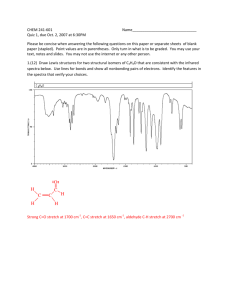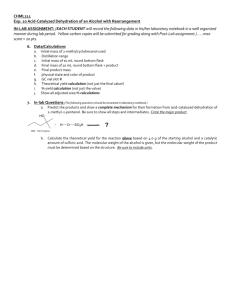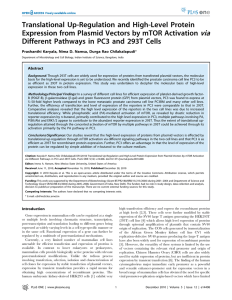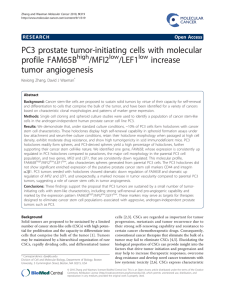pola27813-sup-0001-suppinfo01
advertisement
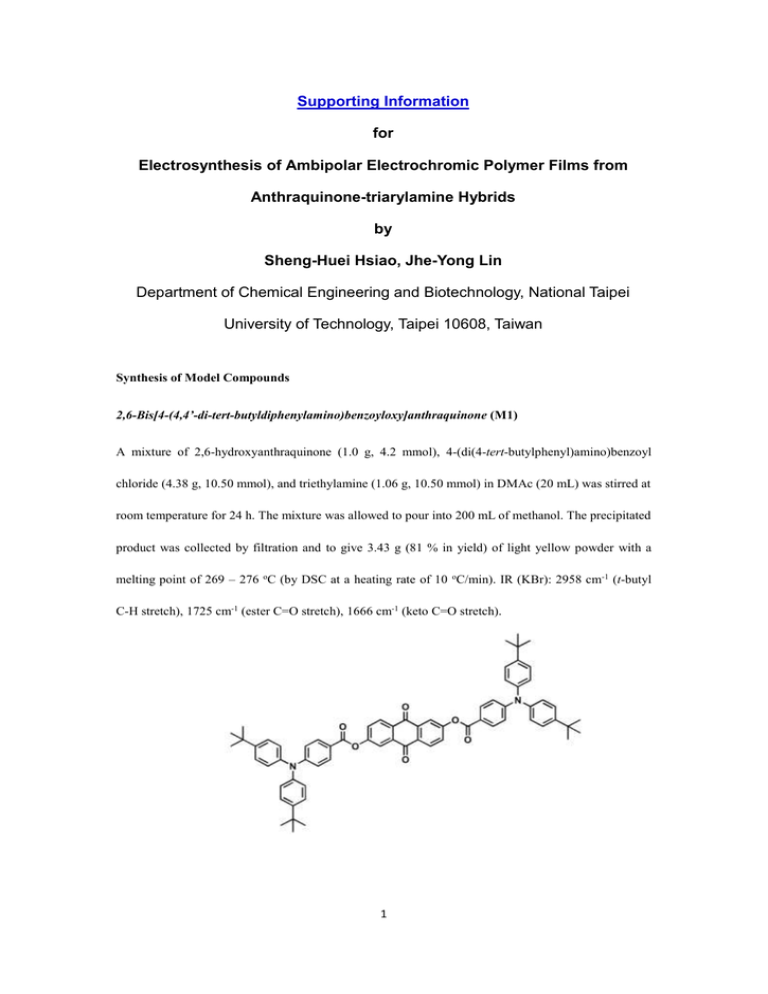
Supporting Information for Electrosynthesis of Ambipolar Electrochromic Polymer Films from Anthraquinone-triarylamine Hybrids by Sheng-Huei Hsiao, Jhe-Yong Lin Department of Chemical Engineering and Biotechnology, National Taipei University of Technology, Taipei 10608, Taiwan Synthesis of Model Compounds 2,6-Bis[4-(4,4’-di-tert-butyldiphenylamino)benzoyloxy]anthraquinone (M1) A mixture of 2,6-hydroxyanthraquinone (1.0 g, 4.2 mmol), 4-(di(4-tert-butylphenyl)amino)benzoyl chloride (4.38 g, 10.50 mmol), and triethylamine (1.06 g, 10.50 mmol) in DMAc (20 mL) was stirred at room temperature for 24 h. The mixture was allowed to pour into 200 mL of methanol. The precipitated product was collected by filtration and to give 3.43 g (81 % in yield) of light yellow powder with a melting point of 269 – 276 oC (by DSC at a heating rate of 10 oC/min). IR (KBr): 2958 cm-1 (t-butyl C-H stretch), 1725 cm-1 (ester C=O stretch), 1666 cm-1 (keto C=O stretch). 1 2,6-Bis[4-(3,6-di-tert-butylcarbazol-9-yl)benzoyloxy]anthraquinone (M2) A mixture of 2,6-hydroxyanthraquinone (1.0 g, 4.2 mmol), 4-(3,6-di-tert-butylcarbazol-9-yl)benzoyl chloride (4.40 g, 10.50 mmol), and triethylamine (1.06 g, 10.50 mmol) in DMAc (20 mL) was stirred at room temperature for 24 h. The mixture was allowed to pour into 200 mL of methanol. The precipitated product was collected by filtration and to give 3.54 g (84 % in yield) orange powder with a melting point of 307 – 314 oC (by DSC at a heating rate of 10 oC/min). IR (KBr): 2954 cm-1 (t-butyl C-H stretch), 1737 cm-1 (ester C=O stretch), 1685 cm-1 (keto C=O stretch). 2-[4-(carbazol-9-yl)benzoyloxy]anthraquinone (M3) A mixture of 2-hydroxyanthraquinone (2.2 g, 0.01 mol), 4-(9H-carbazol-9-yl)benzoyl chloride (3.05 g, 0.01 mol), and triethylamine (1.01 g, 0.01 mol) in DMAc (50mL) was stirred at room temperature for 24 h. The mixture was allowed to pour into 200 mL of methanol. The precipitated product was collected by filtration and to give 4.24 g (86 % in yield) yellow powder with mp = 253 – 256 oC (by DSC at a heating rate of 10 oC/min). IR (KBr): 1736 cm-1 (ester C=O stretch), 1668 cm-1 (keto C=O stretch). 1H NMR (600 MHz, DMSO-d6, δ, ppm): 7.35 (t, J = 7.2 Hz, 2H, Hh), 7.46 (t, J = 7.2 Hz, 2H, Hg), 7.54 (d, J = 7.8 Hz, 2H, Hf), 7.74 (dd, J = 8.4, 2.4 Hz, 1H, Hb), 7.82 (d, J = 8.4 Hz, 2H, He), 7.84 (m, 2H, Hk), 8.16 (d, J = 7.8 Hz, 2H, Hi), 8.22 (d, J = 2.4 Hz, 1H, Hc), 8.35 (m, 2H, Hj), 8.46 (d, J = 8.4 Hz, 1H, Ha), 8.49 (d, J = 8.4 Hz, 2H, Hd). 2 FIGURE S1 IR spectra of model compounds M1-M3. 3 FIGURE S2 (a) 1H NMR and (b) H-H COSY spectra of M3 in CDCl3. 4 SCHEME S1 Synthetic route to the acid chloride compounds. 5 FIGURE S3 DSC curves of AQ(TPA)2 and AQ(Cz)2 with heating rate of o 10 C /min in nitrogen. 6 FIGURE S4 IR spectra of the starting AQ-diol 1 and compounds AQ(TPA)2 and AQ(Cz)2. 7 FIGURE S5 (a) H-H COSY and (b) C-H HMQC spectra of AQ(TPA)2 in CDCl3. 8 FIGURE S6 (a) H-H COSY and (b) C-H HMQC spectra of AQ(Cz)2 in DMSO-d6. 9 SCHEME S2 Electropolymerization and anodic oxidation pathways of the TPB unit. SCHEME S3 Electropolymerization and anodic oxidation pathways of the biscarbazole unit. 10 (a) (b) (c) FIGURE S7 (a), (b) Electrodeposited polymer films on ITO glass from AQ(TPA)2; (c) the polymer film removed from ITO glass substrate. SCHEME S4 Postulated redox chemistry of the AQ segment. 11 FIGURE S8 Repeated CV scanning of model compound M3 between 0 and 1.8 V in 0.1 M Bu4NClO4/MeCN with a scan rate of 50 mV/s. The first CV curves were marked in red. 12 FIGURE S9 The CV diagram of 5 x 10−4 M ferrocene standard in 0.1 M Bu4NClO4/MeCN with a scan rate of 50 mV/s. FIGURE S10 UV-vis absorption spectra of AQ(TPA)2 and AQ(Cz)2 in MeCN and PAQ(TPA)2 and PAQ(Cz)2 polymer films on ITO-glass. 13 FIGURE S11 Scan rate dependence of the electrodeposited films of (a) PAQ(TPA)2 and (b) PAQ(Cz)2 on the ITO-coated glass slide in MeCN containing 0.1 M Bu4NClO4 at different scan rates between 50 and 350 mV/s. 14 FIGURE S12 Potential step absorptometry of the cast films of PAQ(Cz)2 on the ITO-glass slide (coated area: 1 cm2)(in MeCN with 0.1 M Bu4NClO4 as the supporting electrolyte) by applying a potential step: (a) optical switching for PAQ(Cz)2 at potential 0.00 V ↹1.20 V (20 cycles) with a switching time of 17 s, monitored at λmax = 428 nm; (b) the 1st cycle transmittance change for the PAQ(Cz)2 thin film. 15 FIGURE S13 Potential step absorptometry of the cast films of PAQ(Cz)2 on the ITO-glass slide (coated area: 1 cm2)(in MeCN with 0.1 M Bu4NClO4 as the supporting electrolyte) by applying a potential step: (a) optical switching for PAQ(Cz)2 at potential 0.00 V ↹1.44 V (10 cycles) with a switching time of 15 s, monitored at λmax = 757 nm; (b) the 1st cycle transmittance change for the PAQ(Cz)2 thin film. 16

